Intellectual property rights
Why intellectual property rights matter
Intellectual property rights (IPR) govern the ownership, protection, and use of creations of the mind, such as inventions, artistic works, software, designs, and trademarks. They are designed to encourage innovation and creativity by granting creators and inventors exclusive rights to their work. In the digital age, IPR have become even more critical as intangible assets drive economic growth and shape cultural expression.
Civil society involvement in IPR debates may help bring attention to the need to balance protection with access in the public interest, especially in sectors like health, education, and technology.
Key issues in intellectual property rights governance
IPR in transition
As new tools reshape how content is created, shared, and monetised, traditional IPR frameworks face mounting pressure. Global discussions are intensifying around open licensing, patent pools, and the role of artificial intelligence in generating new forms of intellectual property (IP). These changes raise legal and policy questions related to fairness, equitable access, and how intellectual property frameworks apply to evolving sectors.
Access and equity
At its core, IPR policy shapes who benefits from ideas, inventions, and creativity – and who does not. It weaves through the fabric of economic growth, public welfare, and global equity, affecting everything from life-saving medicines to the music we stream and the books we read. Crafting IPR policy, then, is not just a legal exercise, but a careful negotiation between innovation, access, and fairness. Civil society helps navigate these tensions by advocating for policies that respect both individual creators and collective needs.
Digital technologies and IP
Digital technologies are changing how IP is managed and understood. Existing legal frameworks are being tested by new forms of content production that do not always align with traditional definitions of authorship and originality. These changes have intensified debate about the limits of current copyright rules and their ability to remain effective in digital environments. As new technologies, especially AI-generated content, evolve, questions of ownership, attribution, and legal recognition remain central to the discussion.
Innovation and open models
Alternative IPR approaches – such as open-source software, Creative Commons licensing, and knowledge commons – can enable more inclusive innovation ecosystems. These models reduce barriers to entry and encourage shared technological advancement. Civil society can champion open models as sustainable alternatives to proprietary systems.
Forums where intellectual property rights are addressed
Intellectual property rights (IPR) policies are shaped through a layered system of international, regional, and national institutions or trade agreements. At the global level, the World Intellectual Property Organization (WIPO) is central to setting international norms and facilitating treaties that govern patents, copyrights, and trademarks. Alongside WIPO, the World Trade Organization (WTO) plays a critical role through the enforcement of the TRIPS Agreement, which has wide-reaching implications for trade, healthcare, education, and technology transfer.
At the regional level, organisations such as the African Regional Intellectual Property Organization (ARIPO) and the European Patent Office (EPO) contribute to harmonising standards and coordinating enforcement mechanisms across member states. These regional bodies often serve as intermediaries between global frameworks and national implementation.
National institutions, including the United States Patent and Trademark Office (USPTO) and the European Union Intellectual Property Office (EUIPO), are responsible for the direct administration and enforcement of intellectual property laws within their jurisdictions. These offices not only register and protect rights but also contribute to shaping international discourse through their technical expertise and participation in global negotiations.


